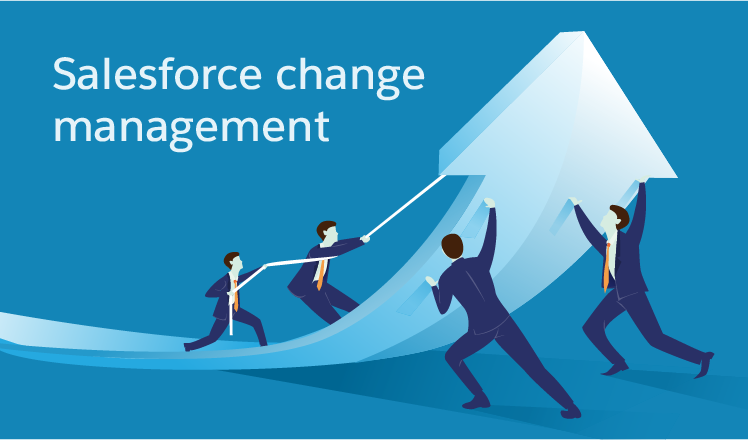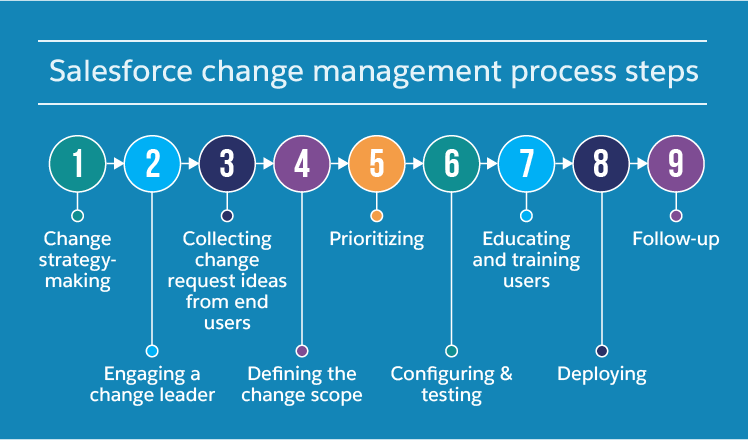How Salesforce change management may reduce change pain
Editor's note: Since 2008 in CRM services, ScienceSoft has accumulated solid expertise in change management. We are ready to share our best practices that will help you embrace the process.
We realize that embracing changes in your Salesforce solution is not a walk in the park. The pitfalls-of-change list includes various functional and adoption issues. However, being ready for the problems you are most likely to encounter means half-solving them, and our guide to successful change management implementation will show you what to do.

What makes changes painful?
Irrational change management or the complete lack of it may lead to a number of painful problems. The reasons to fall back on Salesforce support will probably include:
- Downtime
A change gone wrong can easily create a downtime. Such a situation takes place if a software engineer violates a SOP (Standard Operating Procedure) while implementing changes. Even some minor fixing of software at the support stage, if performed incorrectly, leads to the failure of the CRM and users’ inability to continue their work. - Data corruption or inaccuracy
Problems with data corruption or inaccuracy are not uncommon when changes are implemented. An easy way to encounter data-related problems is to connect a CRM system directly to an outside data source (ERP, DMS, etc.). Even if it’s a simple file import, it may result in duplicate records, bad field updates, or both. - New functionality that unexpectedly hurts users’ work
For example, starting to use the Salesforce mobile application may be confusing to users due to the peculiarities of its interface. Let’s mention, for instance, the mobile page layouts in Salesforce. Not all layouts will load on mobile, even if they’re present in a desktop version of Salesforce Classic or Lightning UI. And if the account page has too many custom fields or formula fields depicted on the computer, its mobile version can leave a user with a narrowed look of the account, giving only key fields and metrics.
Salesforce change management: 9 steps to make
A good change management plan seems indispensable to avoid change pain. Let’s take a large US-based company selling machinery to manufacturing customers as an example. The company operates nationwide and has 3 sales teams in the West, the Southwest, and the Midwest; each team is managed by a sales manager that reports to a sales director. They use Salesforce products (Sales Cloud, Service Cloud, and Community Cloud) and continuously tune them with the help of an external support provider.
As the company constantly grows and its geographically dispersed sales teams (with a number of newly hired employees) should successfully adopt the changes with minimum delay in the sales process, change management is crucially important to the company. Let’s follow their example of a change management process, which comprises the following steps:

1. Change strategy-making
Having studied the audit results of the work of the sales department, the company executives see that the sales rate in the new company branches keeps being tangibly lower than predicted. The sales director introduces a strategy, which outlines the importance of team sales for managing this problem. Enabling team sales will allow boosting the sales levels of the company’s recently opened branches, since more experienced sales reps will be able to assist their colleagues. Team selling is also a good option to effectively engage the branches of the geographically dispersed client companies that are out of reach now. A need for a change management group is also announced to see to the strategy implementation.
2. Engaging a change leader
A powerful leader behind the change management process is a key to its success. The large organization operating all over the country from our example needs a VP of Sales to lead the process. This person provides clear guidance to all the members of the change management group, which includes a training specialist and a developer from the external support provider, sales managers and selected sales reps from 3 teams since it’s they who need to make use of new system capabilities for team sales from A to Z. The change leader will announce the group’s vision to end users and provide measures to ensure all-around adoption of changes.
3. Collecting change request ideas from end users
At this step, the company collects change requests from end users – sales reps. The company’s sales teams use Salesforce Chatter as the most convenient way to provide their ideas. It is a tool to enhance communication via creating posts, commenting on them, joining groups, sharing opinions, and chatting. After creating a Chatter group, the change leader asks the sales reps to share their opinions on the upcoming changes, which aim to improve the sales rate. Some of them offer to share deal-won or lost stories within Chatter groups to help new employees learn. Others insist on sharing their own ideas, updates, and files directly on that opportunity record’s Chatter page in case of team working on the same opportunity.
Another useful functionality, which facilitates communication between end users (the company’s sales reps) and members of the change management group is Salesforce Ideas. Using it, the sales reps vote for the idea about team sales, pinning it to the top of the requests list, which allows the change leader to see the priorities clearly. Also, the change leader responds to the ideas, commenting on the most attractive ones.
4. Defining the change scope
Having considered change requests, the change leader and the change management group decide on how to put these requests into reality. The representatives of the external support provider suggest opting for enabling the Opportunity Teams feature as a means for sales reps’ cooperation while working together on the same opportunity. It’s quite important for the company engaged in complex sales, as there’s a need to build trustworthy relationships with multiple stakeholders and keep in touch with them all along the nurturing process. These tasks are not easy for inexperienced sales reps to manage by themselves and newly hired employees can be united with their experienced colleagues to pursue one opportunity. In this case, a more experienced rep can be assigned the role of an account manager while others will be sales reps. The distribution of the duties gives the newcomers clear guidance on what steps they should take while the experienced sales reps can take more responsibility staying aware of their colleagues’ actions and assist them when needed.
The change management group is planning to implement a custom application within Salesforce to enable a fair estimation of sales reps’ performance and transparency of their reward. The application will allow commission distribution depending on a sales rep’s role in the team and their performance.
5. Prioritizing
When the scope of change is defined as small, the change management group decides to abstain from any major transformations like reviewing and customizing opportunity stages or introducing integrations with external systems and concentrate on enabling Opportunity Teams and creating a custom app for commission distribution. Additionally, it’s decided that a tracking app to see the progress of change implementation will be used by the group members.
6. Configuring & testing
At this stage, there comes to the forefront a need for developing and testing changes in a separate and safe environment, which implies protecting servers and data, vetted source code distributions, and other collections of code, changes’ data that can be damaging to the system or hard to revert. For this purpose, the developer from the external support provider uses a sandbox, which protects the organization’s data.
7. Educating and training users
This stage is critical to make Salesforce changes happen, so the members of the sales teams utilize the sandbox to adjust to a new application and the Opportunity Teams feature in real-life environment and perform User-Acceptance Testing (UAT). A training specialist from the external support provider also gives the users release notes and online training materials and helps them to maximize the adoption of changes.
8. Deploying
At this stage, the Salesforce developer from the external support provider company transfers these changes from the sandbox to production with Change Sets, which helps to streamline changes deployment.
9. Follow-up
After all the necessary procedures of testing and deploying changes have been performed, the members of change management group should evaluate the outcomes and think over some improvements to apply down the road. Reports from the app for tracking change progress show that the process of change went smoothly. Empowered with this information, the change leader holds a meeting with the group. They estimate the changes as successful due to the substantial rise in sales rates and rapid sales reps upskilling. Change management group members decide to continue using Salesforce Chatter for getting ideas from the Salesforce user community on further improvements. For future changes, they agree on carrying out regular surveys to evaluate adoption and creating a help-desk change management application to provide Salesforce technical support.
Finally
Successful Salesforce change management is never an afterthought, it’s a strategy to create ahead of the game and continue right up to the post-launch phase. Even when the changes are minor and don’t require comprehensive transformation, following a solid plan is crucially important for the success of your change project and painless system operations with minimized risks of unplanned downtime or data corruption.

